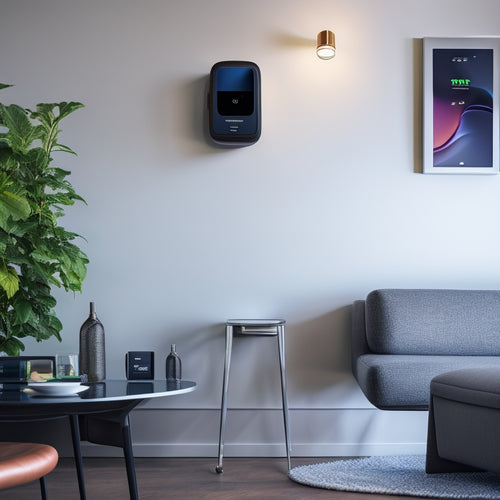
Urban Farming Essentials for Energy-Savvy Home Innovations
Share
You're stepping into urban farming, where innovation meets sustainability, and energy efficiency is key to a thriving harvest. First, choose a location with at least 6 hours of sunlight, water access, and proximity for maintenance. Select crops that fit your climate and personal preferences, and prepare the soil for healthy growth. Consider vertical gardening techniques to maximize space, and incorporate energy-efficient irrigation systems like drip irrigation and rainwater harvesting. As you investigate hydroponic farming and composting, you'll find the perfect balance for your energy-savvy home innovation - and that's just the beginning of your expedition to a bountiful urban farm.
Key Takeaways
- Select crops suitable for local climate and incorporate companion planting for enhanced growth and pest resistance.
- Implement vertical gardening techniques, such as trellises and wall-mounted planters, to maximize space and minimize pesticide use.
- Utilize energy-efficient irrigation methods, including drip irrigation, rainwater harvesting, and soil moisture sensors to conserve resources.
- Consider hydroponic farming for increased crop yields and reduced water usage, and incorporate renewable energy sources for minimal ecological footprint.
- Automate farming tasks with smart software solutions, precision tools, and IoT devices to optimize crop management, reduce labor, and increase yields.
Urban Farming 101: Getting Started
Urban Farming 101: Getting Started
Three essential steps stand between you and a thriving urban farm: choosing the right location, selecting the ideal crops, and preparing the soil.
You'll want to identify a spot that gets at least six hours of sunlight a day, has access to water, and is close to your living space for easy maintenance. Consider joining a community gardening initiative to tap into local knowledge and resources.
When selecting crops, think about what you like to eat and what grows well in your climate. Don't forget to research local regulations regarding urban livestock, like chickens or bees, if you're interested in incorporating them into your farm.
Additionally, incorporating renewable energy solutions, such as solar panels, can help power your farm's infrastructure, reducing your reliance on fossil fuels.
With the rising adoption of electric and hybrid vehicles, you may also consider using electric farming equipment to further minimize your carbon footprint.
With these basics covered, you'll be well on your way to growing your own food and enjoying the freedom that comes with it.
Vertical Gardening for Small Spaces
You'll quickly realize that maximizing vertical space is key to successful urban farming, especially when working with small plots.
Growing upwards efficiently requires careful planning and strategic use of supports, trellises, and wall-mounted planters. By adopting these techniques, you'll be able to increase your yield while keeping your garden compact and manageable.
Moreover, incorporating energy-efficient solutions, such as solar-powered charging, can help reduce your carbon footprint and create a more sustainable urban farming setup.
Maximizing Vertical Space
In small spaces, every inch counts, and maximizing vertical space is essential for urban farmers. You can achieve this by incorporating vertical design elements, such as trellises, arbors, and wall-mounted planters, into your container gardening setup.
This space optimization strategy allows you to grow more plants in a smaller footprint, increasing urban biodiversity and your harvest yield. By going vertical, you'll also make the most of natural light and reduce the need for pesticides and fertilizers.
Additionally, embracing renewable energy sources, such as solar power integration, can further reduce your carbon footprint and promote sustainability. By offsetting your energy consumption with clean energy, you can create a more environmentally friendly urban farm.
With a little creativity, you can turn even the smallest balcony or patio into a thriving urban farm, giving you the freedom to grow your own food and live more sustainably.
Growing Upwards Efficiently
Growing Upwards Efficiently
Creative use of vertical space is key for growing a thriving garden in small areas, and it starts with selecting the right vertical gardening system for your needs. You'll want to take into account factors like sunlight, wind direction, and accessibility when choosing a system. Once you've got your system in place, it's time to think about how to make the most of your space.
| Vertical Gardening Tips | Benefits |
|---|---|
| Use a trellis for climbing plants | Maximizes space, adds visual interest |
| Implement crop rotation | Reduces pests and diseases, increases yield |
| Practice plant companioning | Encourages healthy growth, repels pests |
| Incorporate a drip irrigation system | Conserves water, reduces evaporation |
| Train vining plants to grow upwards | Increases yields, reduces mess |
Energy-Efficient Irrigation Systems
As urban farming continues to evolve, so too must its approach to irrigation, which is why energy-efficient irrigation systems have become a crucial component of sustainable agricultural practices.
You're likely aware that traditional irrigation methods can be water-intensive and energy-hungry, which is why it's important to adopt innovative solutions that prioritize conservation.
Additionally, integrating solar power into irrigation systems can reduce carbon footprint and promote sustainability, as seen in solar power integration for EV charging. By utilizing renewable energy sources, urban farmers can minimize their reliance on fossil fuels and contribute to a cleaner future.
When it comes to energy-efficient irrigation systems, consider the following:
- Drip irrigation: delivers water directly to the roots, reducing evaporation and runoff.
- Rainwater harvesting: collects and stores rainwater for non-potable uses, reducing your reliance on municipal water supplies.
- Smart sensors: monitor soil moisture levels, ensuring you only water when necessary.
- Solar-powered pumps: reduce your energy consumption by utilizing renewable energy from the sun.
Hydroponic Systems for Urban Farms
Take control of your urban farm's crop yields and water usage with hydroponic systems, a soilless method of growing plants that's gaining popularity among urban farmers.
You'll enjoy increased crop yields, reduced water consumption, and precise control over nutrient intake. With hydroponics, you'll provide your plants with exactly what they need, when they need it, via nutrient solutions customized to their growth stages.
Additionally, incorporating renewable energy sources like solar or wind power can further minimize your urban farm's environmental impact.
Regular hydroponic maintenance is essential, so be prepared to monitor pH and nutrient levels, clean the system, and replace solutions as needed.
Sustainable Crop Selection Guide
Now that you've optimized your urban farm's hydroponic system, it's time to focus on selecting crops that will thrive in this environment. You want to choose crops that not only grow well hydroponically but also complement each other and reduce maintenance.
Consider the following principles for sustainable crop selection:
-
Crop rotation: Rotate crops to avoid depleting soil nutrients and reduce pests and diseases.
-
Companion planting: Pair crops that benefit from each other, like planting marigolds with tomatoes to deter nematodes.
-
Disease resistance: Select crop varieties that are resistant to common diseases in your region.
- Seasonal variety: Choose crops that thrive in your local climate and can be harvested at different times to guarantee a continuous yield.
DIY Composting for Urban Farmers
By utilizing the power of composting, you can convert kitchen scraps and organic waste into a nutrient-dense fertilizer that fuels your urban farm's growth. This DIY approach not only reduces waste but also enhances your soil, promoting healthy plant growth.
| Composting Method | Benefits | Challenges |
|---|---|---|
| Traditional Composting | Rich nutrients, easy maintenance | Slow process, potential odors |
| Worm Composting | Fast breakdown, high nutrient content | Requires specific conditions, worm care |
| Bokashi Composting | Ferments organic matter quickly, compact system | Requires specific microorganisms, may have strong odors |
| Vermicomposting | High-quality compost, low maintenance | Requires worm care, may be slow |
| Outdoor Composting | Large capacity, low cost | Weather-dependent, may attract pests |
Remember to maintain your compost bin regularly, ensuring the right balance of "green" and "brown" materials. With the right composting system, you'll enjoy the benefits of nutrient-dense soil and a reduced carbon footprint.
Indoor Farming With LED Lighting
You're likely no stranger to the challenges of growing plants indoors, where natural light is limited.
LED lighting can be a transformative factor, but it's essential to get it right. To enhance your indoor farm, consider the following key factors:
-
LED light range adjustment: Tailor your LED lights to your plants' specific needs, as different ranges promote different growth stages.
-
Energy consumption analysis: Calculate your energy costs and choose LEDs with high lumens-per-watt ratios to minimize expenses.
-
Plant growth cycles: Adjust light duration and intensity according to your plants' growth stages, ensuring ideal development.
- Indoor climate control: Balance temperature, humidity, and air circulation to create a perfect environment for your plants.
Urban Farming Automation Tools
You'll want to invest in smart farming software solutions that can help you monitor and control your urban farm's conditions, ensuring ideal growth and minimizing waste.
Sensors will also play an essential role in automating your farm, providing real-time data on temperature, humidity, and light levels.
Smart Farming Software Solutions
Urban farming's increasing complexity demands more efficient management, and smart farming software solutions have risen to the challenge. As you commence your urban farming expedition, you'll need a reliable system to monitor and control your farm's operations.
Smart farming software solutions provide the precision agriculture tools you need to optimize your yields. These innovative solutions employ data analytics to help you make informed decisions about irrigation, fertilization, and pest control.
Here are four key benefits of smart farming software solutions:
-
Real-time monitoring: Track your farm's performance in real-time, allowing you to respond quickly to any issues.
-
Data-driven decision making: Make informed decisions based on accurate, data-driven information.
-
Automated workflows: Streamline your operations with automated workflows, freeing up more time for you to focus on growth.
- Scalability: Easily scale your operations as your farm grows, without sacrificing efficiency.
Sensors for Optimal Growth
Across the urban farming environment, a multitude of factors converge to impact crop yields, making it crucial to monitor and control them effectively.
You'll need a range of sensor types to guarantee peak growth. Nutrient sensors track soil health, while light sensors monitor intensity and duration. Environmental sensors detect temperature, humidity, and air quality, allowing for precise climate control.
Moisture detection sensors prevent overwatering and underwatering, reducing waste and preserving resources. Data analysis software helps you make sense of the data, providing actionable understandings to improve crop health.
Automated alerts notify you of any issues, confirming you can respond quickly. By leveraging these sensors, you'll be able to fine-tune your urban farm, maximizing yields and minimizing energy consumption.
Smart Water Management Systems
Every drop of water counts in urban farming, and a smart water management system is essential to optimize this precious resource.
You'll want to implement a system that collects and employs rainwater, reducing your reliance on municipal water supplies. This not only saves you money but also gives you control over your water usage.
To create an efficient system, consider the following:
-
Rainwater harvesting: Collect and store rainwater in tanks or barrels for non-potable uses like irrigation and toilet flushing.
-
Install moisture sensors to monitor soil moisture levels, ensuring you're not overwatering or underwatering your crops.
-
Implement a drip irrigation system to deliver water directly to plant roots, minimizing evaporation and runoff.
- Use weather data to schedule watering sessions, avoiding unnecessary watering during rainy or cool weather.
Frequently Asked Questions
Can I Start an Urban Farm in a Rented Property?
You can start an urban farm in a rented property, but first, you'll need to check your lease agreement and discuss your plans with your landlord, considering community involvement and potential impact on the rented space.
How Do I Handle Pests in an Indoor Urban Farm?
You'll prevent pest issues in your indoor farm by using natural pest control methods like neem oil and introducing beneficial insects, while incorporating companion planting to deter unwanted critters, ensuring a thriving and healthy harvest.
Are Urban Farms Eligible for Government Grants or Subsidies?
You'll find that urban farms are indeed eligible for government grants and subsidies; start by researching funding sources and crafting a solid grant application to increase your chances of securing the financial support you need.
Can I Sell My Urban Farm Produce to Local Restaurants?
As you sow the seeds of entrepreneurship, you'll harvest opportunities to supply local restaurants with your fresh produce, forging restaurant partnerships that benefit both parties, and pricing your goods competitively to guarantee a fruitful profit.
Do Urban Farms Require Special Insurance Coverage?
You'll want to contemplate liability protection when running an urban farm, as accidents can happen; investing in specialized insurance policies will give you peace of mind and financial security in case something goes wrong.
Related Posts
-

7 Best EV Battery Health Trackers for Homeowners
You can maximize your electric vehicle's performance and lifespan by leveraging advanced battery health trackers that...
-

7 Best Automated Sprinklers for Water-Wise Green Homes
You're likely among the 75% of U.S. homeowners who use in-ground sprinkler systems, and coincidentally, you're also c...
-

10 Best Sustainable Waste Management Solutions for Green Homes
You're likely unaware that the average green home generates over 2 kilograms of waste daily, but with the right susta...


